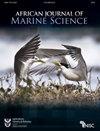蓝桉和牛至精油对纳米比亚海洋物种银鳕鱼麻醉反应的影响
IF 1.4
4区 生物学
Q3 MARINE & FRESHWATER BIOLOGY
引用次数: 1
摘要
研究了蓝桉和牛至精油(EO)的分离和组合对银曲银耳的麻醉效果,并与丁香油丁香油进行了比较。将退化银藻成虫(595.61[SE 11.82]g)暴露于三种浓度的牛至EO(OEO:25、50和100µl l−1)、桉树EO(EEO:300、500和600µl l l-1)及其混合物(12.5µl l-1 OEO至150µl l-1 EEO;12.5µl l-1 OEO至300µl−1 EEO)中,每条鱼作为复制品处理。鱼类还暴露于40µl l−1的丁香油(CEO)中,作为对照。这两种EOs及其混合物被证明具有对退化A.inodorus的麻醉能力。麻醉诱导时间(秒)随着浓度的增加而减少,而恢复反应则相反。只有OEO才有资格成为对退化A.inodorus的理想麻醉剂,尤其是25和50µl l−1,因为这些浓度的麻醉诱导时间小于180 s,恢复时间在300 s内。似乎只有在更高的浓度(600µl−1)或与OEO混合时(在25µl l l-1 OEO至150µl l-1 EEO),EEO才能获得更大的麻醉效果。与丁香油和EEO相比,牛至是一种很有前途的治疗索引齿苋的麻醉剂。然而,进一步的评估被认为是必要的。本文章由计算机程序翻译,如有差异,请以英文原文为准。
The effects of eucalyptus Eucalyptus globulus and oregano Origanum vulgare essential oils on anaesthesia response in a Namibian marine species, silver kob Argyrosomus inodorus
The anaesthetic effectiveness of separate and combined eucalyptus Eucalyptus globulus and oregano Origanum vulgare essential oils (EO) were investigated in silver kob Argyrosomus inodorus and were compared with clove oil Eugenia caryophyllata. Argyrosomus inodorus adults (595.61 [SE 11.82] g) were exposed to three concentrations of oregano EO (OEO: 25, 50 and 100 µl l−1), eucalyptus EO (EEO: 300, 500 and 600 µl l−1), and their mixtures (12.5 µl l−1 OEO to 150 µl l−1 EEO; 12.5 µl l−1 OEO to 300 µl l−1 EEO; 25 µl l−1 OEO to 150 µl l−1 EEO), with each fish treated as a replicate. Fish were also exposed to 40 µl l−1 of clove oil (CEO), which acted as a control. The two EOs and their mixtures proved to possess anaesthetic capacity in A. inodorus. Anaesthesia induction time (seconds) decreased with increased concentrations, whereas the inverse was reported for the recovery response. Only OEO qualified as an ideal anaesthetic agent for A. inodorus, especially 25 and 50 µl l−1, as the anaesthesia induction times with these concentrations were less than 180 s and recovery was within 300 s. It seems that EEO could achieve greater anaesthetic effectiveness only at a higher concentration (600 µl l−1) or when mixed with OEO (at 25 µl l−1 OEO to 150 µl l−1 EEO). This study introduces oregano as a promising anaesthetic in A. inodorus compared with clove oil and EEO. However, further evaluations are deemed necessary.
求助全文
通过发布文献求助,成功后即可免费获取论文全文。
去求助
来源期刊

African Journal of Marine Science
生物-海洋与淡水生物学
CiteScore
2.60
自引率
16.70%
发文量
17
审稿时长
6-12 weeks
期刊介绍:
The African (formerly South African) Journal of Marine Science provides an international forum for the publication of original scientific contributions or critical reviews, involving oceanic, shelf or estuarine waters, inclusive of oceanography, studies of organisms and their habitats, and aquaculture. Papers on the conservation and management of living resources, relevant social science and governance, or new techniques, are all welcomed, as are those that integrate different disciplines. Priority will be given to rigorous, question-driven research, rather than descriptive research. Contributions from African waters, including the Southern Ocean, are particularly encouraged, although not to the exclusion of those from elsewhere that have relevance to the African context. Submissions may take the form of a paper or a short communication. The journal aims to achieve a balanced representation of subject areas but also publishes proceedings of symposia in dedicated issues, as well as guest-edited suites on thematic topics in regular issues.
 求助内容:
求助内容: 应助结果提醒方式:
应助结果提醒方式:


